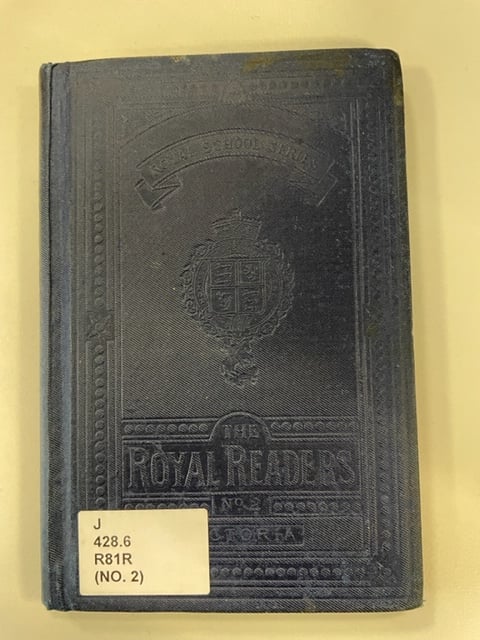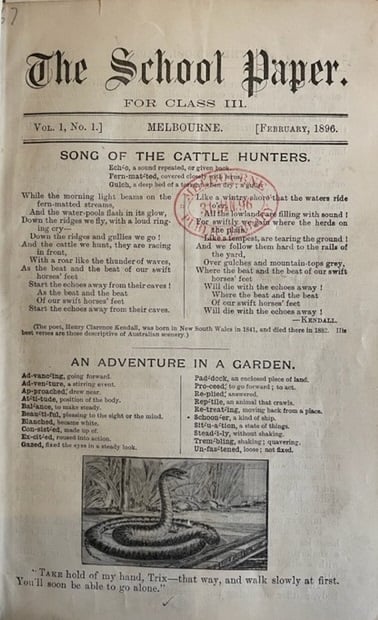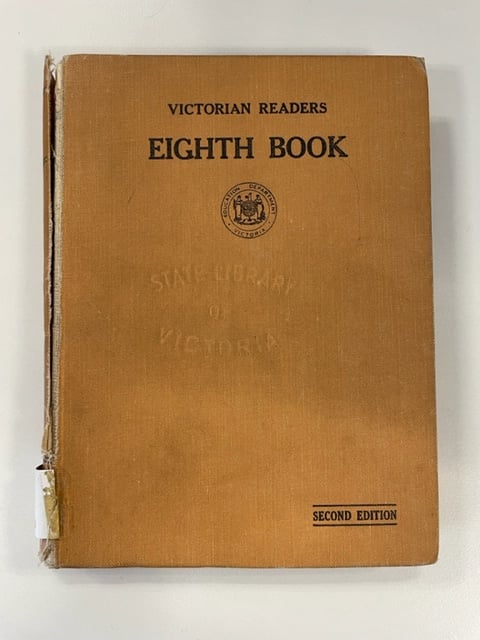This year marks the 150th anniversary of public education in Victoria. To celebrate and reflect, we’re taking a look at educational texts from the 19th and 20th centuries.
School readers and textbooks are important resources as they offer insights into educational standards, values and behaviours taught in schools, and the social, political and cultural issues of a particular time period. In her examination of pioneering in school readers, Jane McGennisken describes school readers as providing ‘a fruitful avenue for exploring the role of educational institutions in the formation of an Australian national imaginary’. 1 The school reader was essentially ‘an anthologised collection of stories, poems, illustrations, essays and extracts from longer works…’ which ‘informed the day-to-day classroom rituals of reading, re-reading, inspection, testing and advancement’. 2
Irish National Readers and Royal Readers
In 1872 the Victorian Education Act called for the provision of free, compulsory and secular education. Prior to this Act, the most commonly used educational texts in Australia were the Irish National Readers. 3
With the introduction of the Act, Australia’s education system moved away from religious teaching towards increased government involvement in the education system, mimicking what was occurring in England. 4
As such the Irish National Readers were replaced in 1877 by Royal Readers, which moved away from providing a religious education and focused largely on English literature and the history of the British Empire, while still providing some moral instruction. 5
School papers
Over time the appetite for educational texts that included local content grew, and thus, in 1896, the Victorian Education Department started to produce monthly School Papers, which interspersed locally produced content with the standard British offerings. 6
‘In the pages of The School Paper elementary students in the state school system were presented with stories, poems, articles and pictures that encouraged a sense of patriotism by celebrating unique aspects of Australian life while simultaneously articulating the values of an imperial identity to which any vision of Australia must be indelibly tied’ 7
The School Papers were compulsory reading for children until 1928, when the Victorian Readers became compulsory and the School Papers supplemented them. The three grades of School Papers were renamed in the late 1960s to become Meteor, Comet and Orbit.
Victorian school readers
The Victorian Readers were a series of school readers (eight in number) produced between 1928 and 1930 for school children in Victoria and used (with revisions) until the 1950s. 8
The preface to the eighth book noted: ‘Though it was recognized that the local production of a series of reading-books to compare favourably with those issued by leading British publishers would not be easy of accomplishment, yet it was believed that the effect of the use of such a series in the schools and in the pupils’ homes would make the effort well worth while’. 9

This series was more distinctively Australian (about a quarter of its content was required to be local), although this local material continued to exist within the context of British imperialism. 10
The Australian content largely focused on life in the bush, despite the fact that most of the students would have lived in the suburbs, 11with characters such as ‘the pioneer, the bushman and the Anzac’ all well represented.12 The scope of acceptable characters and lifestyles covered was narrow and remained colonial, while a focus on taming the landscape provided ‘a way of displacing the conflict between settlers and [i]ndigenous peoples onto a more acceptable narrative of a direct conflict between the settler and the land itself’. 13
By the late 1960s, these readers had been largely overtaken in schools by commercially-produced reading materials. 14
Accessing school readers at State Library Victoria
The Library holds some Royal Readers. An advanced search for the series title Royal school series will list our holdings.
The State Library holds all School Papers and readers. To view our holdings, see our family tree chart.
We also hold all Victorian Readers, including the two editions produced 1928-29, and the second edition (produced in the 1940s with quite different content). 1980s reprints of the first edition, issued by the Education Department, are also held. See also the School papers family tree chart for title variations.
The database AustLit has an index for the contents of the Victorian readers and school papers from the late 19th century until the end of 1930, then all grades for 1940.
Further resources
Deakin University has a wonderful online exhibition of Australian school textbooks.
More information about Victoria’s education system can be found in the research guide: School and Education History in Victoria
Further information on educational texts from the 1500s onwards, can be found in the Children’s Literature research guide
References
- McGennisken, G, 2010, ‘Huts in the wilderness: pioneering in school readers’, Journal of Australian Studies, vol 34, no 1, p 45
- As above, p 35
- Deakin University, n.d., 19th century school readers – Irish national readers, Fusion Deakin Exhibits Online website, viewed 22 April 2022
- Dermer, A, 2018, ‘Imperial values, national identity’, History of Education Review, vol 47, iss 1, p 25
- Deakin University, n.d., 19th century readers – the Royal readers, Fusion Deakin Exhibits Online website, viewed 22 April 2022
- Deakin University, n.d., 19th century readers – School Papers, Fusion Deakin Exhibits Online website, viewed 22 April 2022
- McGennisken, G, 2010, ‘Huts in the wilderness: pioneering in school readers’, Journal of Australian Studies, vol 34, no 1, p 37
- Victorian Collections, 2019, Book, the Victorian Readers, 1986, Victorian Collections website, viewed 22 April 2022
- Long, C, (ed.), 1929, The Victorian readers eighth book, Victoria Education Department, Melbourne
- Victorian Collections, 2019, Book, the Victorian Readers, 1986, Victorian Collections website, viewed 22 April 2022
- King, B, 2012, ‘The Victorian readers’, Spirit of Progress, Vol 13, Iss 1, pp 20-23
- McGennisken, G, 2010, ‘Huts in the wilderness: pioneering in school readers’, Journal of Australian Studies, vol 34, no 1, p 43
- Curthoys, A, 2000, ‘Mythologies’ in R. Nile (ed), The Australian legend and its discontents’, University of Queensland Press, St. Lucia
- Victorian Collections, 2019, Book, the Victorian Readers, 1986, Victorian Collections website, viewed 22 April 2022, preface





I remember in the 1960s, they replaced the older readers for grades prep to 3. We had John and Betty (for prep), Holidays (Grade 2) and ‘Among Friends’ for grade 3. 9I can’t remember the title for grade 1). ‘Among Friends’ was full of poems and stories of all kinds from around the world. It had Robert Louis Stevenson poems (‘Up the airy mountain’) and my favourite story, from Czechoslovakia, I think, ‘Trying to please everybody.’ I’ve always found that one useful!
Hi The new look Grade 1 reader may have been called Playmates. The frequently referenced John and Betty was introduced ahead of Playmates and Holidays. In my rural school (Rokewood) I was taught with John and Betty followed by the ‘old’ First and Second Readers (soft cover editions) My Second Grade Reader is still with me and the black and white illustrations are remembered for their strong style and line.
I agree with Barbara’s comments (above) particularly on the importance of the John and Betty readers in the infant grades. By the way, the title of the Grade 1 book was ‘Playmates’. As a young teacher in Victorian rural schools in the early 60s, the ‘John and Betty’ readers proved invaluable in teaching kids to read, as did the picture/word & sentence flashcard sets that accompanied them. I later found out that the author, Betty Somerville, taught me in Grade 1, at South West Brunswick State School. Rumour has it that the ‘John’ in the series was her boyfriend, an Australian soldier, was killed in WWII, and that the ‘Betty’ was herself.
Grade 1 was Playmates and Grade 4 was Gather Around
The 1950s John and Betty was about as exciting as a coma. But the story in the Victorian Readers #2 of the Hobyahs creep creep creeping, that unnerving folktale-like story is seared into my childhood mind.
Having older siblings allowed me the pleasure of reading the stories in their “Victorian Readers”. I especially liked reading the Eighth Book. It was an old brown book. I think I felt “grown up” reading it when I was only in grade three or four.
These readers were first published by the Victorian Education Department in 1928/1930. Second editions emerged during the 1940’s. One-quarter of the content was required to be Australian.
In The Victorian Readers I read about cyclones in Queensland (and the eye of the storm). I learned about Aboriginal trackers and feats of heroic rescues.
I read about droughts and floods and fires.
I learned of the “deadly feuds of class and creed and race” as Henry Lawson described them: Tensions between squatters and selectors; tensions between Scots, Irish and English; tensions between Aboriginal people and invaders.
The Fire At Ross’s Farm still makes me teary, as sworn enemies join together to fight the fire:
“The beaten flames gave way
Two grimy hands in friendship joined –
And it was Christmas Day.”
Another memorable story is ‘Lost in the Bush’ in the Grade 4 reader (Fourth Book).
It relates the tale of Jane Duff, who was lost in the bush with her two brothers for over a week. Search parties failed to find her until Aboriginal trackers were brought in on the eighth day. My father was able to add a personal dimension to that story. Dad grew up in the Wimmera district. He spoke about the high regard Wimmera people had for the Aboriginal trackers who found the Duff children. Even though these men had died before my father was born, apparently the local admiration for Yanggendyinanyuk aka “King Richard” and his legendary skills lived on. When Dad was a school-child, Jane Duff visited his school and told them of being rescued by “King Richard” and her eternal gratitude. She was an old woman by that stage. She must have spoken passionately about him as dad had a strong recollection of it and the gentleness of Yanggendyinanyuk when he found her. Jane Duff had kept the dress she was wearing when lost and showed it to the class. Dad recalled the dress as a small frock of green and white cheesecloth or gauze, very tattered and torn from her ordeal.
Yanggendyinanyuk is remembered for his dignity and resilience in enduring the devastating effects of European colonisation. He is featured on the Silo at Horsham, titled Yangga Dyata – Walking on Country.
Then there is The Drover’s Wife!
Topical at the moment as a new version of The Drover’s Wife that has just been released as a feature film. Leah Purcell is lead actor, writer, director and co-producer of the film. Leah’s mother used to read this Henry Lawson story to her as a child. Purcell began writing “The Drover’s Wife, The Legend of Molly Johnson” eight years ago. Leah has re-shaped it to reflect her family history, highlighting the elements of racism, frontier violence and gender violence so often air-brushed from our history.
In Henry Lawson’s Drover’s Wife, the un-named woman is living in a small bush hut with her children. Her husband has been away droving for six months when she spots a snake disappear under their hut.
The story details her all-night vigil as she waits for the snake to reappear. Near dawn the snake emerges and is killed by the drover’s wife. © JCM 16/06/2022
Does anyone else have vivid memories of stories first met in the Victorian Readers?
I remember those readers too, Betty. And that story ‘Trying to please everybody’. There was a lesson in it. Folk tales usually teach something useful and timely.
I also remember ink wells and dipping pens. It was a country school with a Big Room and a Little Room and two teachers. Big Room had the desks lined up according to grades. By the time l got to grade 6 we moved from cartridge ink pens to ball points.
And now pens and paper have made way to computers. I still like pen and paper — it is a different process holding a pen making symbols. But here l am today using new tech. and l am about to get up have breakfast and read a newspaper–old school. I like the mix.
I have just found my ‘workbooks’ linked to Playmates. So I would have been 6 years old in Grade 1. The year 1960. The teacher printed out sentences ( on a spirit duplicator, judging by the colour of the print) and pasted in a hand made book. Children then illustrated the page. Little has changed. Similar strategies are used in today’s literary learning.
I, too, have fond memories of these readers. Unfortunately I did not keep any of them.
I have little recollection of Gather Round, apart from the fact the title just popped into my head last week!
I seem to recall the title page of The Open Road (which may have been for Grade 5), but don’t remember the blue hard cover.
In Grade 6 (1965) we had Travelling On – I distinctly remember the tan cover with kangaroo shapes.
I used to love reading these – even in my summer holidays I would re-read the books from previous years, along with doing the arithmetic exercises from those textbooks.
How can I get copies of the set of 8 books. I remember just the title of Lost in the bush part one and would love to read it again. I was a pupil of Kindergarten of the air when I first stared as my parents were Missionaries in New Britain. I think my first year of School was up at Euroa primary School Victoria.
Hi Margaret,
As these books are no longer in print, you’d need to look for secondhand copies. You could have a look online or even try your luck at some op shops. It also appears that the University of Melbourne has digitised all 8 volumes and these can be accessed at: https://digitised-collections.unimelb.edu.au/collections/89c7b9f6-8f0d-5afe-a019-e77cf359135a?spc.sf=dc.date.available&spc.sd=DESC